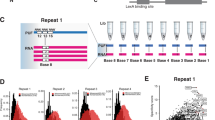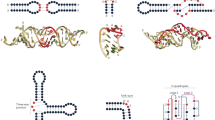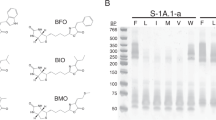Abstract
We have isolated an RNA with specific affinity for the L-valine side chain, using selection-amplification. The active RNA secondary structure, identified by repeated selection, is a highly conserved asymmetric (4:10) internal loop adjacent to required G-U pairs. The binding free-energy per methylene is up to 1.5 kcal mol−1 and very dependent on group position. Amino acid binding is L-stereoselective and distinguishes aliphatic sidechains by size and, given the same total size, by configuration. Though aliphatic-RNA interactions have frequently been neglected, their avidity and specificity seem sufficient for a biological role.
This is a preview of subscription content, access via your institution
Access options
Subscribe to this journal
Receive 12 print issues and online access
$189.00 per year
only $15.75 per issue
Buy this article
- Purchase on Springer Link
- Instant access to full article PDF
Prices may be subject to local taxes which are calculated during checkout
Similar content being viewed by others
References
Tuerk, C. & Gold, L. Systematic evolution of ligands by exponential enrichment: RNA ligands to bacteriophage T4 DNA polymerase. Science 249, 505–510 (1990).
Ellington, D. & Szostak, J.W. In vitro selection of RNA molecules that bind specific ligands. Nature 346, 818–822 (1990).
Robertson, D.L. & Joyce, G.F. Selection in vitro of an RNA enzyme that specifically cleaves single-stranded DNA. Nature 344, 467–468 (1990).
Famulok, M. & Szostak, J.W. Stereospecific recognition of tryptophan agarose by in vitro selected RNA. J. Am. chem. Soc. 114, 3990–3991 (1992).
Connell, G.J., Illangesekare, M. & Yarus, M. Three small ribooligonucleotides with specific arginine sites. Biochemistry 32, 5497–5502 (1993).
Cheong, C. & Moore, P.B. Solution structure of an unusually stable RNA tetraplex containing G- and U-quartet structures. Biochemistry 31, 8406–8414 (1992).
Tanford, C. Contribution of hydrophobic interactions to the stability of the globular conformation of proteins. J. Am. chem. Soc. 84, 4240–4247 (1962).
Hansch, C. & Coats, E. α-Chymotrypsin: A case study of substituent constants and regression analysis in enzymic structure-activity relationships. J. Pharm. Sci. 59, 731–743 (1970).
Dorovska, V.N., Varfolomeyev, S.D., Kazanskaya, N.F., Klyosov, A.A. & Martinek, K. The influence of the geometric properties of the active centre on the specificity of α-chymotrypsin catalysis. FEBS Lett. 23, 122–124 (1972).
Fersht, A.R., Shindler, J.S. & Tsui, W.-C. Probing the limits of protein-amino acid side chain recognition with the aminoacyl-tRNA synthetases. Discrimination against phenylalanine by tyrosyl-RNA synthetases. Biochemistry 19, 5520–5524 (1980).
Crick, F.H.C. On protein synthesis, Symp. soc. exp. Biol. 12, 138–163 (1958).
Kissinger, C.R., Liu, B.S., Martin-Blanco, E., Kornberg, T.B. & Pabo, C.O. Crystal structure of an engrailed homeodomain-DNA complex at 2.8 Å resolution: a framework for understanding homeodomain DNA interactions. Cell 63, 579–590 (1990).
Kim, Y., Geiger, J.H., Hahn, S. & Sigler, P.B. Crystal structure of a yeast TBP/TATA-box complex. Nature 365, 512–520 (1993).
Kim, J.L., Nikolov, D.B. & Burley, S.K. Co-crystal structure of TBP recognizing the minor groove of a TATA element. Nature 365, 520–527 (1993).
Pai, E.F., Kabsh, W., Krengel, U., Holmes, K.C., John, J. & Wittinghofer, A. Structure of the guanine-nucleotide-binding domain of the Ha-ras oncogene product p21 in the triphosphate conformation. Nature 341, 209–214 (1989).
Ia Cour, T.F., Nyborg, J., Thirup, S. & Clark, B.F.C. Structural details of the binding of guanosine diphosphate to elongation factor Tu from E coli as studied by X-ray crystallography. EMBO J. 4, 2385–2388 (1985).
Rould, M.A., Perona, J.J. & Steitz, T.A. Structural basis of anticodon-loop recognition by glutaminyl-tRNA synthetase. Nature 352, 213–218 (1991).
Yarus, M. RNA-amino acid affinity, in The RNA World (eds Gesteland, R.F. & Atkins, J.F.) 205–217 (Cold Spring Harbor Laboratory Press, New York, 1993).
Weber, A.L. & Miller, S.L. Reasons for the occurence of the twenty coded protein amino acids. J. molec. Evol. 17, 273–284 (1981).
Castro, B., Dormoy, J.R., Evin, G. & Selve, C. Reactifs de couplage peptidique IV (1) - L'hexafluorophosphate de benzotriazolyl N- oxytrisdimethylamino phosphonium (B.O.P). Tetrahedron Lett. 14, 1219–1222 (1975).
Jaeger, J.A., Turner, D.H. & Zuker, M. Predicting optimal and suboptimal secondary structure for RNA. Meth. Enzym. 183, 281–306 (1990).
Author information
Authors and Affiliations
Rights and permissions
About this article
Cite this article
Majerfeld, I., Yarus, M. An RNA pocket for an aliphatic hydrophobe. Nat Struct Mol Biol 1, 287–292 (1994). https://doi.org/10.1038/nsb0594-287
Received:
Accepted:
Issue Date:
DOI: https://doi.org/10.1038/nsb0594-287
This article is cited by
-
Highly selective and sensitive detection of glutamate by an electrochemical aptasensor
Analytical and Bioanalytical Chemistry (2022)
-
Leveraging nature’s biomolecular designs in next-generation protein sequencing reagent development
Applied Microbiology and Biotechnology (2020)
-
A Realistic Model Under Which the Genetic Code is Optimal
Journal of Molecular Evolution (2013)
-
RNA–Amino Acid Binding: A Stereochemical Era for the Genetic Code
Journal of Molecular Evolution (2009)
-
On the origin of the genetic code: signatures of its primordial complementarity in tRNAs and aminoacyl-tRNA synthetases
Heredity (2008)



